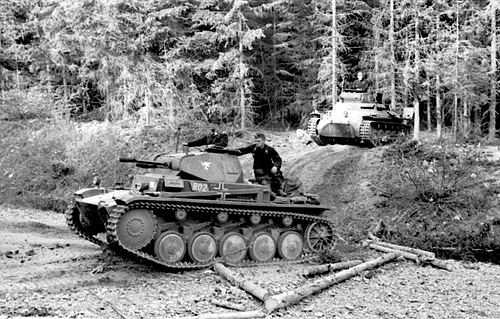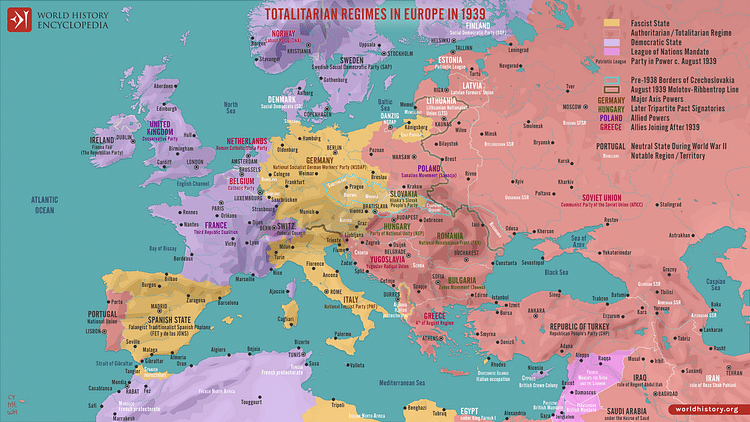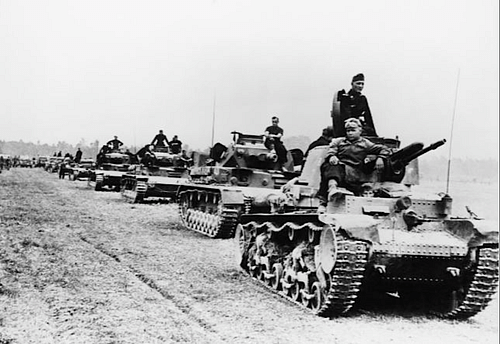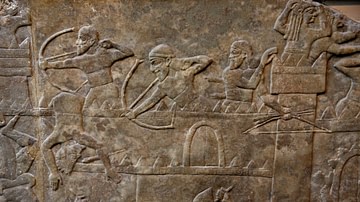
Blitzkrieg ('lightning war') is a military tactic combining air and land forces deployed at speed against the enemy's weaker points while the rear lines are simultaneously disrupted by acts of sabotage and bombing. Speed, concentration, and surprise are designed to psychologically overwhelm the enemy, wreck its command structure, and cause a total collapse without having to completely destroy the enemy.
Blitzkrieg was developed from earlier tactics in the 19th century, where armed forces such as artillery and cavalry were used in concentration and deployed at pace, but the first successful use with mechanised weapons was by the German armed forces during the Spanish Civil War (1936-39) and, on a much larger scale, in the first years of the Second World War (1939-45). The tactic continues to be employed in modern warfare.
Origins
The Prussian general Carl von Clausewitz (1780-1831) is often credited with pioneering the idea of Blitzkrieg in his book On War, published posthumously in 1832. The army of Prussia deployed forces in concentration and with an emphasis on speed during the Napoleonic Wars (1803-15). Clausewitz also emphasised the importance of launching attacks on enemy forces which, through sheer power of numbers, speed, and surprise, would negatively affect them in psychological terms. Another advantage of the tactic is that it can be used by relatively small armies, such as Prussia's of that period, to counterbalance an enemy's numerical advantage.
A further development came in the 1920s with the ideas of the commander of the German Army, General Hans von Seeckt (1866-1936). Seeckt led an army which was then limited in size (100,000 men) by the Treaty of Versailles, which had formally concluded the First World War (1939-45). To overcome a size disadvantage compared to other European armies, Seeckt emphasised speed and mobility in field tactics, even if Germany was forbidden to possess both tanks and aircraft for military purposes. To get around the restriction, Seeckt used mock-ups and sent units to the USSR for secret training. The idea of using combined arms, that is, mobile infantry, armoured vehicles, mobile artillery, and aircraft in such a way that disrupted and penetrated enemy lines was not unique to Germany as it was also endorsed by such military strategists in Britain as Major-General J. F. C. Fuller (1878-1966) and Basil Liddell Hart (1895-1970). It was the German Army, though, that would be the first to use the Blitzkrieg tactics in practice.
The term Blitzkrieg, meaning 'lightning war' because of the emphasis on speed, "has been attributed to Hitler, and was probably coined for intimidation purposes" (Dear, 109). The historian A. Gilbert suggests that Adolf Hitler (1889-1945), the leader of Nazi Germany, first used the term Blitzkrieg in a political speech in 1935. Hitler was intent on expanding German-controlled territory. The Blitzkrieg tactic perfectly suited Germany's armed forces, which were smaller than some of its rivals in numbers in 1939 but much more modern in terms of equipment. Technology such as radios (including inside tanks) and telephone lines, which could be quickly laid in new areas, allowed commanders to maintain contact with their forward troops or even to personally join those forward units while still being able to direct the rest of the army. The training of German officers emphasised independent decision-making, which also helped increase the speed of troop movements in the field since orders could be adapted to the needs of the situation at hand.
The commanders of the French Army, in contrast to all this mobility, were still disposed to emphasise static defences such as the Maginot Line. Tanks were part of the French Army, but these were deployed as a backup to the static defences and were not part of aggressive, attack-focussed tactics. In many ways, the French and British commanders were still sitting on their laurels of victory from WWI. In that war, trench battles had been typical. WWI was a conflict of attrition, that is, the aim was to use superior numbers to wear down an enemy by eliminating its soldiers at a rate faster than one lost one's own troops. Blitzkrieg, on the other hand, had an entirely different objective, as here explained by the historian B. Pitt:
The basic principle behind the Blitzkrieg technique is that it is simpler, easier, and cheaper to reduce the strength of an enemy army by starvation (cutting off its supplies) or by paralysis (destroying its High Command or cutting its communication and control lines) than by battering it to a bloody pulp.
(Liddell Hart, 19-20)
Total War
Blitzkrieg was very much the tactic of total warfare. All elements of a nation's armed forces were to be used such as the air force, armoured vehicles, artillery, infantry, and special forces like engineers and saboteur units. Concentration was often achieved by attacking on a very narrow front. What the German Army described as the Schwerpunkt may be loosely translated as the 'centre of gravity' of the whole attack, the point identified in the enemy positions which was to be subjected to the concentrated main effort of the Blitzkrieg manoeuvre.
Blitzkrieg involved a propaganda aspect where the enemy's morale was undermined prior to the physical attack through the distribution of misinformation via leaflets, posters, and radio broadcasts. In the actual attack, air and land warfare were combined for maximum devastation. Bombers hit enemy defences and lines of communication, supplies, and concentrations of reserves behind the main battlefield. Armoured columns, primarily of tanks, but also with entirely motorised infantry divisions and mobile artillery support, then punched through the Schwerpunkt, often deliberately bypassing the strongest positions of defence. Specialised engineering units ensured the speed of the attack was maintained by building temporary pontoon bridges over rivers and other obstacles when required. At the same time, specially trained troops were used behind enemy lines, often parachuted in to create havoc with the enemy's communications, transport, and utilities networks. This subversive aspect of the campaign meant that the enemy commanders found it very difficult to respond to the main attack or even know the state of the battle and the condition of their forces. Finally, the concentrated nature of the attack and relentless bombardment, made at specifically identified target areas, usually meant that the enemy was overwhelmed psychologically, an objective which included targetting civilians who could be fired upon when trying to flee, for example, bombed towns, further impeding the enemy's ability to move troops where they were needed.
The aim of a commander employing the Blitzkrieg tactic was to either punch right through the enemy lines or outflank them using high-speed armoured columns. A Kesselschlacht or 'cauldron battle' situation was then created by these encircling manoeuvres. Now motorised infantry followed up the main thrust of the attack, surrounding those parts of the enemy lines which had been left unaffected by the initial armoured columns punching through. The ultimate result of Blitzkrieg was the annihilation of the enemy's command structure and logistics support, thus bringing about the total surrender of the enemy forces.

The Blitzkrieg Campaigns
Poland
Although practised to a limited degree by Germany's forces in the Spanish Civil War, the full and terrible potential to knock out an enemy force using Blitzkrieg tactics was first seen in the invasion of Poland in 1939. Germany attacked Poland on 1 September and swept aside the Polish army. Aircraft like the Messerschmitt Bf 109 fighter, Heinkel He 111 medium bomber, and Junkers Ju 87 'Stuka' dive bomber, which could deliver bombs with the precision of heavy artillery, were deployed in large numbers. Tanks used included the weak Panzer I with very limited firepower but also the much better Panzer II with a 37 mm (1.4 in) gun and 7.92 mm (0.3 in) machine gun. Blitzkrieg tactics resulted in most of the Polish air force being destroyed on the ground by German bombers. Bombers destroyed Polish airfields, roads, railway networks, and any military target they could identify. German transport aircraft ensured the advancing army was kept well supplied. Kraków was captured on 6 September. Warsaw, the capital, surrendered on 27 September. The speed of the fall of Poland was extraordinary. As The Oxford Companion to World War II notes:
The tally sheet of the September campaign reflects the success of the Blitzkrieg doctrine. German casualties in the four-week campaign numbered under 50,000 with 8,082 killed, 27,278 wounded, and 5,029 missing. Polish losses were significantly higher, with an estimated 70,000 officers and men killed and about 130,000 wounded…The Polish armed forces simply succumbed to a more numerous and better equipped foe employing a new and deadly military doctrine.
(707-8)
Low Countries & France
Blitzkrieg tactics were again successfully used by Germany in the Norwegian campaign of April 1940 and in Luxembourg, Belgium, and the Netherlands the following month. These campaigns involved parachuting troops behind enemy lines to create chaos. Once again, the speed of the tactic reaped dividends as armies collapsed one after the other.

Next came the most devastating blow of all, the Fall of France. The French army had more tanks than the German army, and some of these were even superior, but the concentrated nature of the Blitzkrieg tactics used the German armour much more efficiently. The French generals took the opposite approach and spread out their armour in a long defensive line, which was too thin to meet the threat. The German air force's medium bombers hit strategically important targets behind the French lines while 'Stuka' dive bombers were used to support directly the advancing German armour and infantry on the ground by attacking defensive strong points directly in their path. Achieving surprise by attacking through the Ardennes, thought to be unsuitable terrain for vehicles, the German Army outflanked the Maginot Line and attacked it from the relatively unprotected rear. The speed of Germany's victory surprised even the German generals, but Hitler's orders to halt the advance meant that the Allies were able to remove to the safety of Britain around 340,000 British, French, and Allied soldiers in the Dunkirk evacuation of May-June 1940. Paris was captured on 14 June. The French government moved to Bordeaux and surrendered on 22 June. The catastrophic defeat of France had taken just six weeks. Once again, Blitzkrieg had proved not only successful but also efficient in cost to the attackers. As The Oxford Companion to World War II again notes:
France [suffered] losses estimated at 90,000 dead, 200,000 wounded, and 1.9 million taken prisoners or missing…for a cost of 29,640 German dead (army and air force) and a total casualty figure of 163,213.
(326)
Balkans & North Africa
Blitzkrieg was again successfully deployed in Germany's campaigns in the Balkans in the spring of 1941. Another theatre where these tactics were used was in the North Africa Campaign. The German commander Erwin Rommel (1891-1944), a veteran of the Battle of France campaign, repeatedly used Blitzkrieg tactics, skilfully combining planes and tanks to punch above his weight against an enemy with far superior numbers. The Allies, at least in the first years of the desert war, dissipated their numerical advantage by not using their tanks in concentration. Rommel was expert at ensuring his forces, especially his elite and fully mechanised Afrika Korps, could attack with great speed and at points that the enemy least expected an attack to come from such as through an area of difficult terrain or by deploying troops in a wide arc that completely outflanked the enemy's defensive positions. The Allies suffered several notable defeats such as at the Battle of Kasserine Pass in February 1943, where Rommel launched a classic surprise attack through difficult terrain using Blitzkrieg tactics, but they did eventually learn the advantages of this new type of warfare and employed them to ultimately defeat the German and Italian armies in Africa.

Limitations: Barbarossa
When Hitler decided to attack the USSR in Operation Barbarossa of June 1941, Blitzkrieg proved, after some early successes, much less effective in the longer term since the vast distances involved in this campaign overtaxed the German armed forces' logistics. Speed, an essential component of the tactic, was compromised, and so battles became much more static such as the long drawn-out Battle of Stalingrad (1942-3). As in Africa, Germany's opponents had also learnt from the earlier campaigns of WWII and responded in kind, even when in a defensive position. Dogged Soviet defence and repeated counterattacks, the overstretched supply lines of the German army, irreplaceable German losses in men and material, and harsh winter weather all wore down the invaders. The German army did not secure Moscow, the capital, as planned, and it was obliged to fight a defensive war of retreat on the Eastern Front. In short, "the defeat before Moscow was a serious setback, an indisputable failure of the Blitzkrieg concept" (Dear, 89).
Germany ultimately lost WWII, but the Blitzkrieg tactic has been used in many more wars since, particularly in the Middle East. Blitzkrieg is still used today by those armed forces able to combine air and land power for a concentrated effect where the numbers of personnel and machines mean far less than just how they are deployed.







